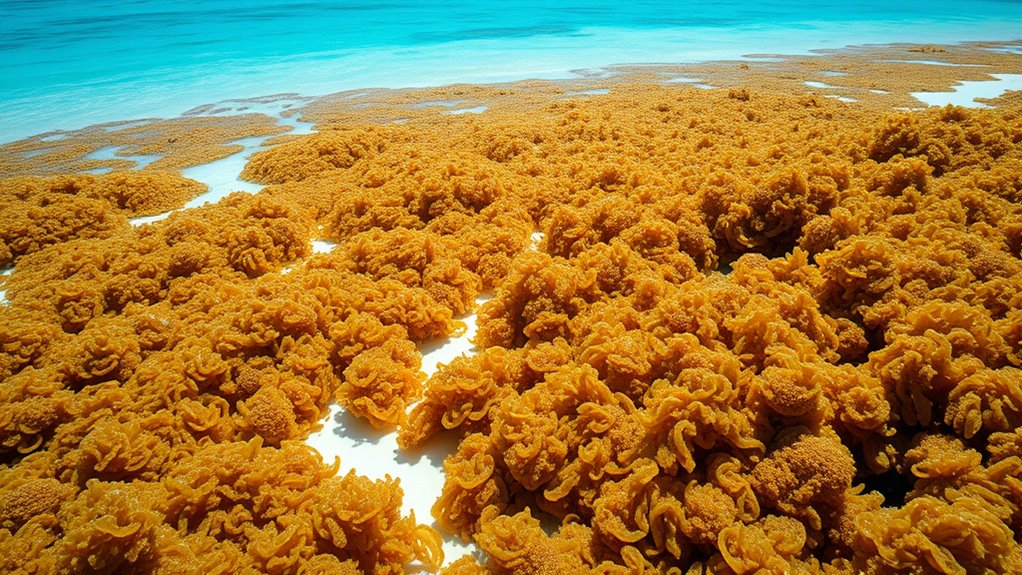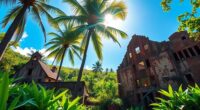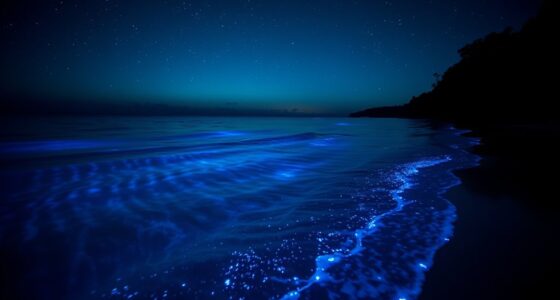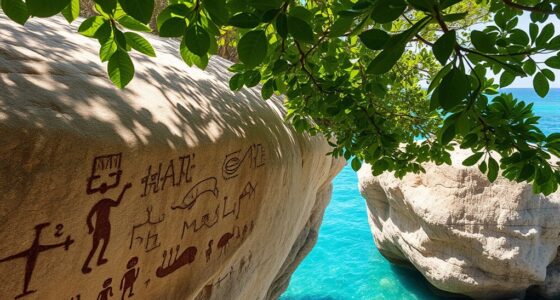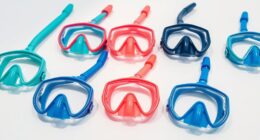Sargassum seaweed is a natural part of the Caribbean’s marine ecosystem, providing habitat and supporting biodiversity. However, when large quantities wash ashore, they become a coastal challenge by affecting water quality, harming marine life, and ruining beach tourism. Climate change, nutrient runoff, and ocean currents influence its presence. If you’re curious about how this seaweed can be both a friend and foe, there’s more to explore below.
Key Takeaways
- Sargassum seaweed naturally supports marine ecosystems but can accumulate excessively along Caribbean beaches.
- Large sargassum blooms disrupt water quality, hinder marine life, and release harmful gases during decomposition.
- While beneficial for nutrient cycling, excessive seaweed impacts tourism, causing beach closures and economic losses.
- Management involves labor-intensive cleanup and exploring sustainable uses like fertilizer or bioenergy.
- Balancing ecological benefits with economic challenges is essential for sustainable Caribbean coastal health.

Have you ever wondered what sargassum seaweed is and why it’s becoming a topic of concern? Sargassum is a type of floating brown seaweed that drifts across the Atlantic Ocean and piles up along Caribbean shores in massive quantities. While it plays a natural role in the marine ecosystem, recent increases in its presence have sparked worries among locals and tourists alike. You might notice beaches covered in thick mats of seaweed, which can transform scenic coastlines into less inviting areas. But beyond the aesthetic impact, sargassum’s presence considerably influences coastal tourism, a critical industry for many Caribbean nations. When beaches become overwhelmed with seaweed, visitors often stay away, leading to economic downturns for businesses that rely on tourism. This creates a cycle where local economies suffer, and communities struggle to find solutions.
The rise in sargassum blooms is linked to various environmental factors, including nutrient runoff from agriculture, climate change, and ocean current shifts. These blooms disrupt the delicate balance of the marine ecosystem by affecting water quality, light penetration, and marine life. Fish and other sea creatures that depend on clear waters and healthy habitats find it harder to survive when thick layers of sargassum cover the surface. Furthermore, decomposing seaweed releases gases like hydrogen sulfide, which can be harmful to both marine life and human health. This cascade of effects underscores how interconnected the marine ecosystem truly is and highlights the importance of addressing the root causes of these blooms. Additionally, the increased presence of sargassum can impact water quality, leading to further ecological challenges.
For local communities, the challenge lies in managing the influx of sargassum without damaging the environment further. Cleanup efforts often involve removing the seaweed from beaches, but these can be labor-intensive and costly. Some regions have experimented with turning sargassum into useful products like fertilizer or bioenergy, aiming to reduce waste while creating economic opportunities. However, these solutions are not always enough to counteract the scale of the problem. As a visitor or resident, you might notice that beaches sometimes close temporarily or that certain areas are less accessible due to accumulated seaweed. These measures, while necessary, also serve as reminders of the ongoing struggle to balance environmental health with economic sustainability. Ultimately, understanding the complex role of sargassum in both the marine ecosystem and coastal tourism helps you appreciate the importance of sustainable practices and proactive solutions to protect these beloved Caribbean beaches.
Frequently Asked Questions
How Does Sargassum Affect Local Marine Ecosystems?
You might notice that sargassum impacts local marine ecosystems by altering marine biodiversity and nutrient cycling. As it accumulates, it provides habitat for some marine species but can also smother coral reefs and seagrass beds, reducing biodiversity. Decomposing sargassum releases nutrients into the water, which can disrupt natural nutrient cycling. Overall, while it offers benefits, excessive amounts of sargassum can threaten the balance and health of marine ecosystems.
What Are Innovative Methods to Remove Sargassum From Beaches?
You’re exploring innovative ways to clear sargassum from beaches. Biodegradable barriers can trap seaweed without harming the environment, making cleanup easier and eco-friendly. Robotic removal systems offer efficient, automated solutions that can collect large amounts quickly. Combining these methods, you can effectively manage sargassum, reducing beach pollution and protecting tourism. These technologies represent promising advancements in sustainable beach maintenance efforts.
Can Sargassum Be Used for Commercial Purposes?
Imagine you’re in a sci-fi movie, but this time, sargassum’s real. You can turn this algae into valuable products, like algae-based products used in cosmetics or animal feed. Its biofuel potentials also look promising, offering a sustainable energy source. So yes, sargassum can be commercially valuable, helping you reduce environmental impact while creating new economic opportunities. It’s a smart way to turn a problem into profit.
How Does Sargassum Influence Tourism Industry Revenue?
You’ll find that sargassum impacts the tourism industry’s revenue by affecting the visitor experience. When large amounts wash ashore, they can make beaches less attractive, discouraging tourists and lowering spending. This economic impact hits local businesses and communities hard. However, if managed well, sargassum can be turned into useful products, potentially boosting the economy. Overall, its presence influences tourism flow and revenue, shaping the future of Caribbean destinations.
Are There Long-Term Solutions to Sargassum Overgrowth?
You might wonder if long-term solutions exist for sargassum overgrowth. Yes, there are options like sargassum mitigation techniques and improved coastal management strategies. These involve deploying barriers, promoting sustainable land use, and monitoring ocean currents. While no solution is perfect yet, combining these efforts can reduce impacts over time, helping protect beaches and support local economies. Active management is key to tackling this ongoing challenge effectively.
Conclusion
As you walk along the Caribbean shores, remember that sargassum seaweed is more than just a pesky nuisance—it’s the heartbeat of this delicate ecosystem. While it may seem like an unstoppable tide, your actions can tip the balance between chaos and harmony. Think of it as the ocean’s own call for help; if you ignore it, the impact could be as overwhelming as a tsunami. Respect and understanding are your best tools to protect these treasured beaches.

